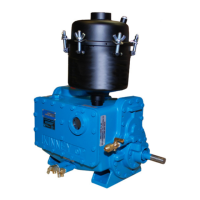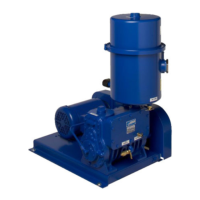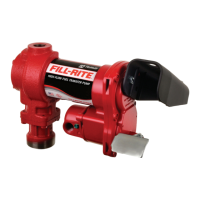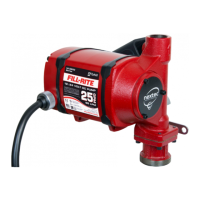19
06
Troubleshooting
Manual 1807 Rev B p/n 001807 0000
SYMPTOM PROBABLE CAUSE REMEDIES
Pump stalls
Electrical power loss Check power at the pump.
Pump malfunctioning
Contaminated pump
oil or insufcient
lubrication
See Stalling on page 17. See V-Belt on page 7
and Changing the Oil on page 14.
Blocked pump
discharge line
Clear the pump discharge line. Check the oil mist
eliminator element for blockage.
Pump will not start
Electrical failure
Check for power at the pump. Check the motor start
controls and motor.
Pump ooded with oil
Clear oil from the pump by turning over by hand or
disassembling the pump. See Flooding on page 15.
Excessively low
temperature
Heat the pump to minimum starting temperature of
50°F (10°C).
Oil discharged from oil
mist eliminator
Excess oil on discharge
side of oil mist
eliminator
Unscrew the oil mist eliminator and pour oil through the
discharge tting back into the pump.
Reduce pump inlet pressure below 10 Torr to allow
collected oil to drain back through the integral check
valve in the oil mist eliminator.
Table 6-1– Common Symptoms and Remedies
CHECKING PUMP PERFORMANCE
If the processing time increases or the ultimate
pressure becomes poor with no recent changes
in the process or in the system conguration, test
the pump to determine whether the trouble is in
the pump or the connected process equipment. To
check the condition of the pump, use a McLeod
gauge to measure the blank-off pressure as
described in the following procedure.
OTE: N If possible, also read the blank‑off
pressure with a thermistor or
thermocouple gauge. See Figure 6-1 and
Table 6-1 for common faults in vacuum
systems.
Figure 6-1 – Pump Test Manifolding
To read the pump blank-off pressure:
1. Close off the pump inlet by means of a vacuum
valve or short segment of manifolding, as
shown in Figure 6-1.
2. Connect a vacuum gauge to the pump side of
the valve or manifolding. Position the gauge
connection so that it will not become ooded or
blocked by splashing pump oil.

